Person-Centred Care: Communication Skills for Nursing Students
VerifiedAdded on 2023/06/16
|9
|2166
|96
Essay
AI Summary
This essay explores the crucial role of communication skills in nursing and healthcare, emphasizing person-centered care. It covers various communication strategies, including verbal and non-verbal techniques like SOLER and SURETY, essential for building trusting relationships with patients. The essay identifies common barriers to effective communication, such as lack of trust, disinterest, cultural differences, and offers solutions to overcome these challenges. Furthermore, it examines the legal, professional, and ethical frameworks relevant to nursing practice, including the ethical duty of care, the Equality Act 2010, and professional standards for nurses, focusing on prioritizing people and practicing effectively. Ethical considerations like informed consent and disclosure are also discussed, highlighting the importance of patient rights and confidentiality. The essay concludes that effective communication is fundamental to providing quality care and empowering patients in healthcare settings.
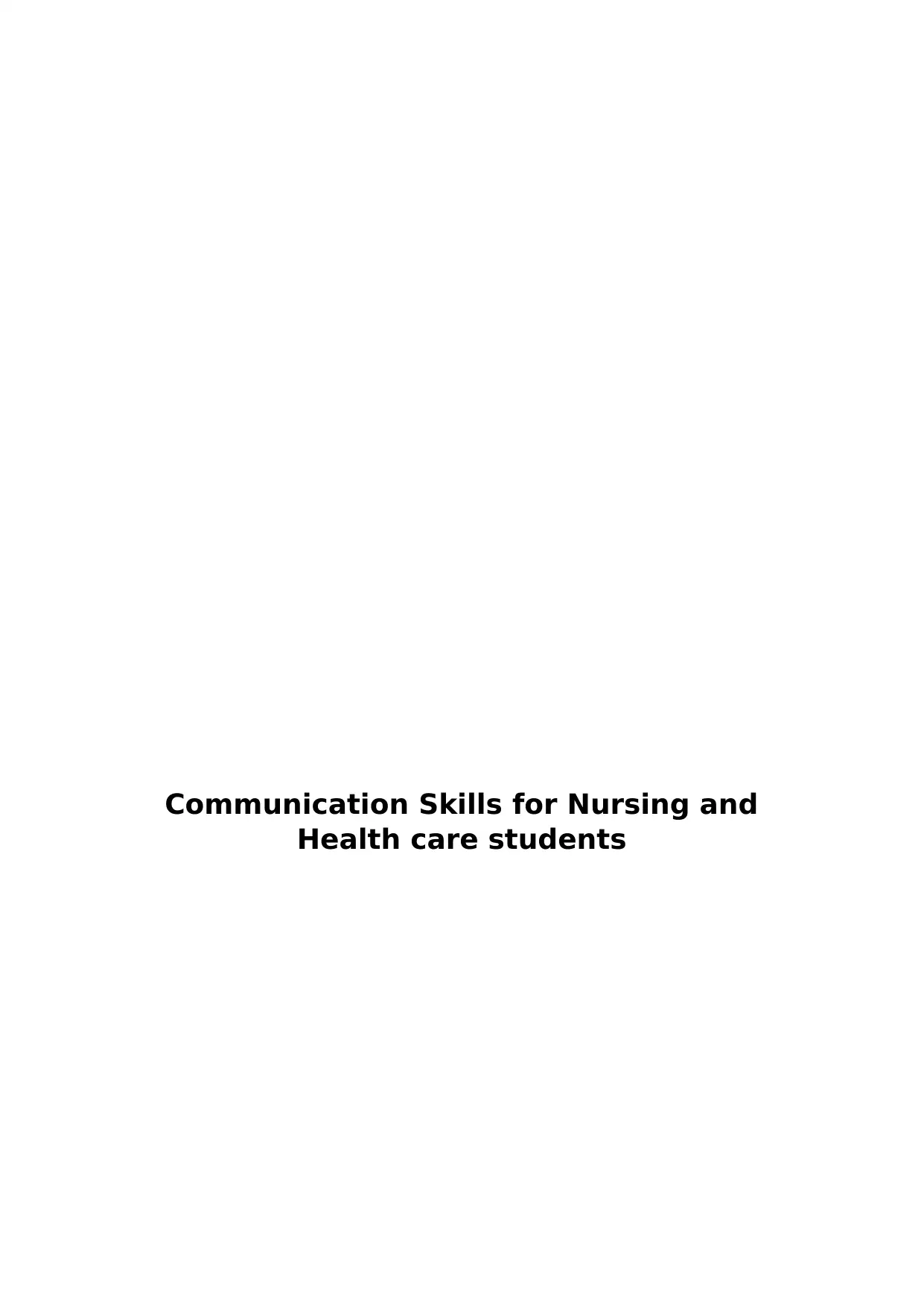
Communication Skills for Nursing and
Health care students
Health care students
Paraphrase This Document
Need a fresh take? Get an instant paraphrase of this document with our AI Paraphraser
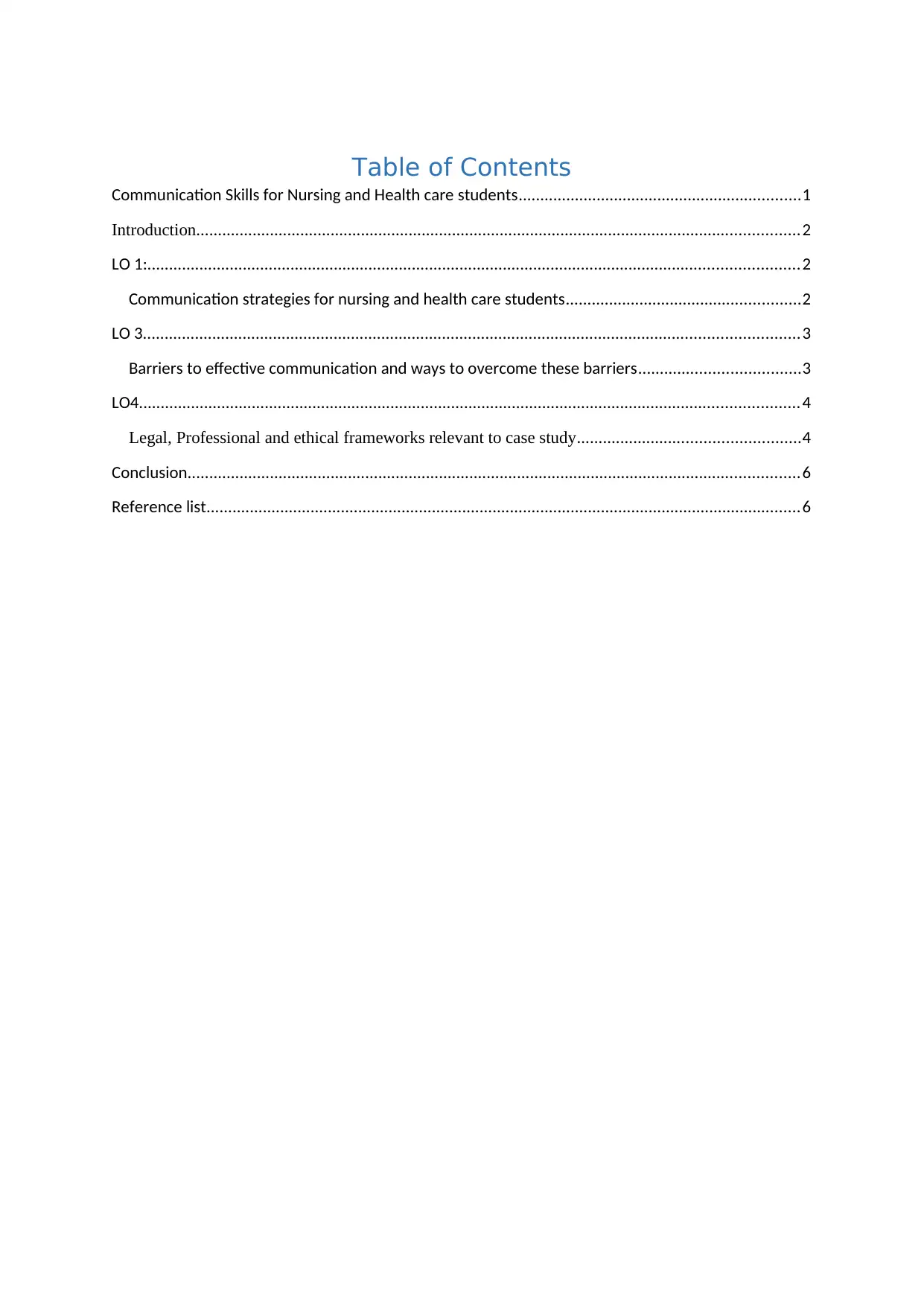
Table of Contents
Communication Skills for Nursing and Health care students.................................................................1
Introduction...........................................................................................................................................2
LO 1:......................................................................................................................................................2
Communication strategies for nursing and health care students......................................................2
LO 3.......................................................................................................................................................3
Barriers to effective communication and ways to overcome these barriers.....................................3
LO4........................................................................................................................................................4
Legal, Professional and ethical frameworks relevant to case study...................................................4
Conclusion.............................................................................................................................................6
Reference list.........................................................................................................................................6
Communication Skills for Nursing and Health care students.................................................................1
Introduction...........................................................................................................................................2
LO 1:......................................................................................................................................................2
Communication strategies for nursing and health care students......................................................2
LO 3.......................................................................................................................................................3
Barriers to effective communication and ways to overcome these barriers.....................................3
LO4........................................................................................................................................................4
Legal, Professional and ethical frameworks relevant to case study...................................................4
Conclusion.............................................................................................................................................6
Reference list.........................................................................................................................................6
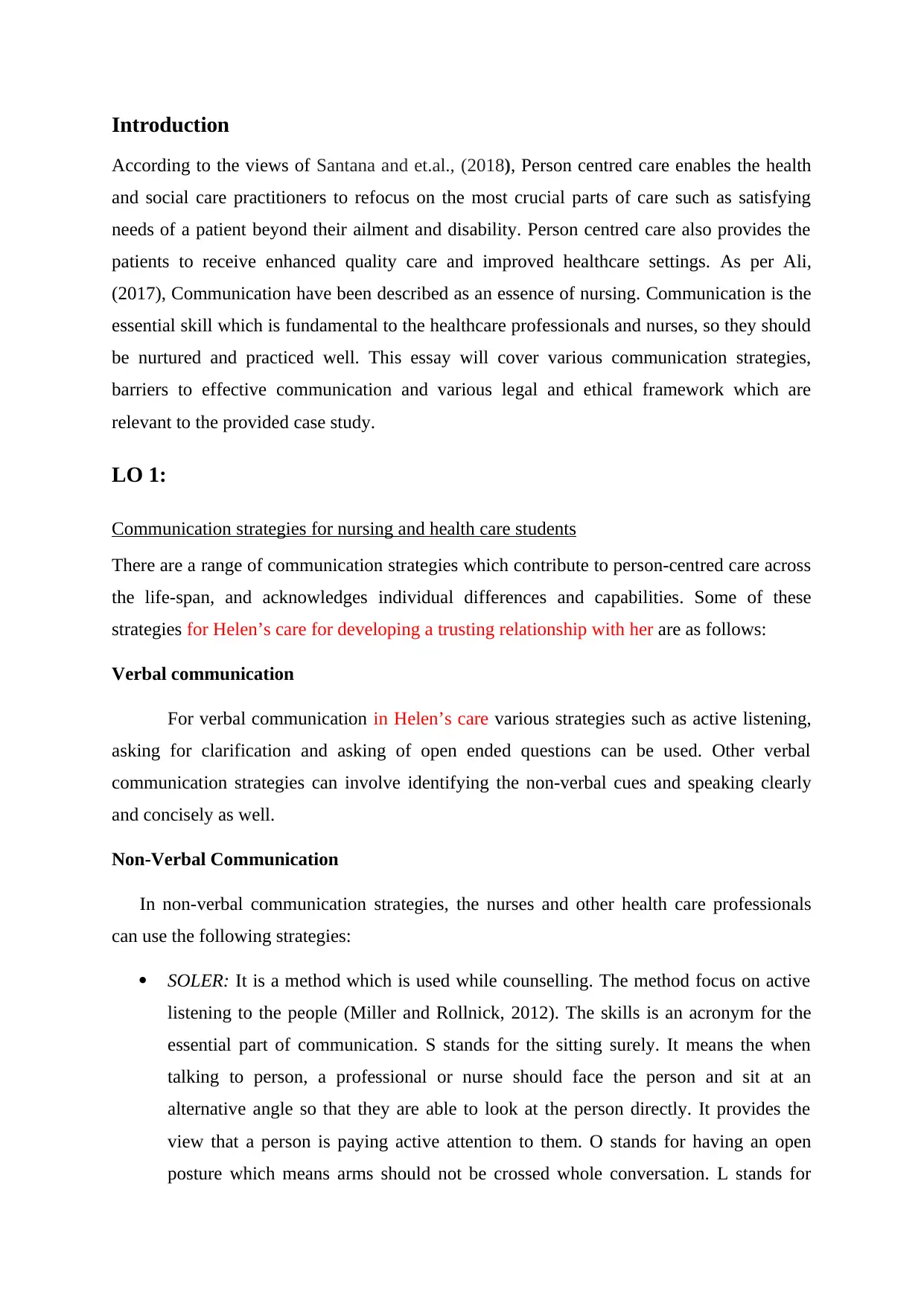
Introduction
According to the views of Santana and et.al., (2018), Person centred care enables the health
and social care practitioners to refocus on the most crucial parts of care such as satisfying
needs of a patient beyond their ailment and disability. Person centred care also provides the
patients to receive enhanced quality care and improved healthcare settings. As per Ali,
(2017), Communication have been described as an essence of nursing. Communication is the
essential skill which is fundamental to the healthcare professionals and nurses, so they should
be nurtured and practiced well. This essay will cover various communication strategies,
barriers to effective communication and various legal and ethical framework which are
relevant to the provided case study.
LO 1:
Communication strategies for nursing and health care students
There are a range of communication strategies which contribute to person-centred care across
the life-span, and acknowledges individual differences and capabilities. Some of these
strategies for Helen’s care for developing a trusting relationship with her are as follows:
Verbal communication
For verbal communication in Helen’s care various strategies such as active listening,
asking for clarification and asking of open ended questions can be used. Other verbal
communication strategies can involve identifying the non-verbal cues and speaking clearly
and concisely as well.
Non-Verbal Communication
In non-verbal communication strategies, the nurses and other health care professionals
can use the following strategies:
SOLER: It is a method which is used while counselling. The method focus on active
listening to the people (Miller and Rollnick, 2012). The skills is an acronym for the
essential part of communication. S stands for the sitting surely. It means the when
talking to person, a professional or nurse should face the person and sit at an
alternative angle so that they are able to look at the person directly. It provides the
view that a person is paying active attention to them. O stands for having an open
posture which means arms should not be crossed whole conversation. L stands for
According to the views of Santana and et.al., (2018), Person centred care enables the health
and social care practitioners to refocus on the most crucial parts of care such as satisfying
needs of a patient beyond their ailment and disability. Person centred care also provides the
patients to receive enhanced quality care and improved healthcare settings. As per Ali,
(2017), Communication have been described as an essence of nursing. Communication is the
essential skill which is fundamental to the healthcare professionals and nurses, so they should
be nurtured and practiced well. This essay will cover various communication strategies,
barriers to effective communication and various legal and ethical framework which are
relevant to the provided case study.
LO 1:
Communication strategies for nursing and health care students
There are a range of communication strategies which contribute to person-centred care across
the life-span, and acknowledges individual differences and capabilities. Some of these
strategies for Helen’s care for developing a trusting relationship with her are as follows:
Verbal communication
For verbal communication in Helen’s care various strategies such as active listening,
asking for clarification and asking of open ended questions can be used. Other verbal
communication strategies can involve identifying the non-verbal cues and speaking clearly
and concisely as well.
Non-Verbal Communication
In non-verbal communication strategies, the nurses and other health care professionals
can use the following strategies:
SOLER: It is a method which is used while counselling. The method focus on active
listening to the people (Miller and Rollnick, 2012). The skills is an acronym for the
essential part of communication. S stands for the sitting surely. It means the when
talking to person, a professional or nurse should face the person and sit at an
alternative angle so that they are able to look at the person directly. It provides the
view that a person is paying active attention to them. O stands for having an open
posture which means arms should not be crossed whole conversation. L stands for
⊘ This is a preview!⊘
Do you want full access?
Subscribe today to unlock all pages.

Trusted by 1+ million students worldwide

lean forwards. It indicates that the person is interested in the conversation. E stands fir
eye contact. In communication making eye contact is very crucial. R stands for
relaxed body language. It indicates that the person in not in any hurry. This method
can be used in the case of Helen as well. As Helen is sometimes not aware of her
surroundings and asks various questions. This technique can be used to counsel her.
SURETY: It is the framework which is used in nurse education. This is a strategy
which is essential for the health care professionals such as a nurse for non-verbal
communication skill. It stands for following:
S: Sit at an angle
U: Uncross legs and arms
R: Relax
E: Eye contact
T: Touch
Y: Your intuition
Communication skills for nursing and health care students
Communication is the important tool which enables health and social care professionals
to improve the health and empower the users of service (Stickley, 2011). Communication
skills are important because it enables the nurses and health care professionals to collaborate
on the teams as well with other disciplines. Some of the essential skills are as follows:
Active listening: This skill enables the nurses to understand other people’s
experiences.
Verbal communication: The nurses must speak with clarity honesty and accuracy.
Non-Verbal communication: The nurses must be able to use the non-verbal elements
such as facial expression, body language and eye contact in creating support.
Presentation skills: these skills are important for making handovers and demonstrating
the expertise and knowledge
Trust: Trust creation is an important skill as through building trust, the patient can be
made to feel comfortable.
eye contact. In communication making eye contact is very crucial. R stands for
relaxed body language. It indicates that the person in not in any hurry. This method
can be used in the case of Helen as well. As Helen is sometimes not aware of her
surroundings and asks various questions. This technique can be used to counsel her.
SURETY: It is the framework which is used in nurse education. This is a strategy
which is essential for the health care professionals such as a nurse for non-verbal
communication skill. It stands for following:
S: Sit at an angle
U: Uncross legs and arms
R: Relax
E: Eye contact
T: Touch
Y: Your intuition
Communication skills for nursing and health care students
Communication is the important tool which enables health and social care professionals
to improve the health and empower the users of service (Stickley, 2011). Communication
skills are important because it enables the nurses and health care professionals to collaborate
on the teams as well with other disciplines. Some of the essential skills are as follows:
Active listening: This skill enables the nurses to understand other people’s
experiences.
Verbal communication: The nurses must speak with clarity honesty and accuracy.
Non-Verbal communication: The nurses must be able to use the non-verbal elements
such as facial expression, body language and eye contact in creating support.
Presentation skills: these skills are important for making handovers and demonstrating
the expertise and knowledge
Trust: Trust creation is an important skill as through building trust, the patient can be
made to feel comfortable.
Paraphrase This Document
Need a fresh take? Get an instant paraphrase of this document with our AI Paraphraser
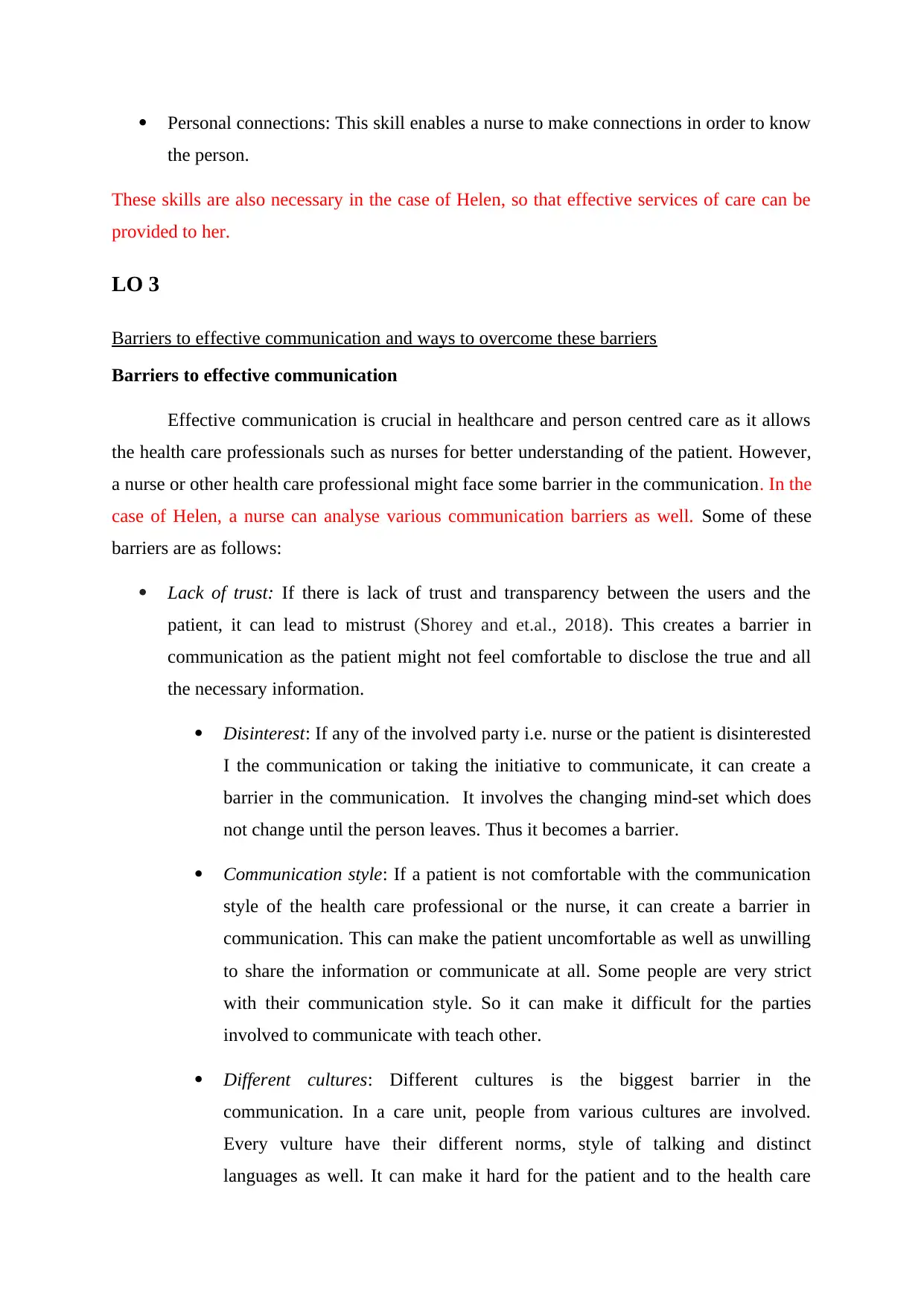
Personal connections: This skill enables a nurse to make connections in order to know
the person.
These skills are also necessary in the case of Helen, so that effective services of care can be
provided to her.
LO 3
Barriers to effective communication and ways to overcome these barriers
Barriers to effective communication
Effective communication is crucial in healthcare and person centred care as it allows
the health care professionals such as nurses for better understanding of the patient. However,
a nurse or other health care professional might face some barrier in the communication. In the
case of Helen, a nurse can analyse various communication barriers as well. Some of these
barriers are as follows:
Lack of trust: If there is lack of trust and transparency between the users and the
patient, it can lead to mistrust (Shorey and et.al., 2018). This creates a barrier in
communication as the patient might not feel comfortable to disclose the true and all
the necessary information.
Disinterest: If any of the involved party i.e. nurse or the patient is disinterested
I the communication or taking the initiative to communicate, it can create a
barrier in the communication. It involves the changing mind-set which does
not change until the person leaves. Thus it becomes a barrier.
Communication style: If a patient is not comfortable with the communication
style of the health care professional or the nurse, it can create a barrier in
communication. This can make the patient uncomfortable as well as unwilling
to share the information or communicate at all. Some people are very strict
with their communication style. So it can make it difficult for the parties
involved to communicate with teach other.
Different cultures: Different cultures is the biggest barrier in the
communication. In a care unit, people from various cultures are involved.
Every vulture have their different norms, style of talking and distinct
languages as well. It can make it hard for the patient and to the health care
the person.
These skills are also necessary in the case of Helen, so that effective services of care can be
provided to her.
LO 3
Barriers to effective communication and ways to overcome these barriers
Barriers to effective communication
Effective communication is crucial in healthcare and person centred care as it allows
the health care professionals such as nurses for better understanding of the patient. However,
a nurse or other health care professional might face some barrier in the communication. In the
case of Helen, a nurse can analyse various communication barriers as well. Some of these
barriers are as follows:
Lack of trust: If there is lack of trust and transparency between the users and the
patient, it can lead to mistrust (Shorey and et.al., 2018). This creates a barrier in
communication as the patient might not feel comfortable to disclose the true and all
the necessary information.
Disinterest: If any of the involved party i.e. nurse or the patient is disinterested
I the communication or taking the initiative to communicate, it can create a
barrier in the communication. It involves the changing mind-set which does
not change until the person leaves. Thus it becomes a barrier.
Communication style: If a patient is not comfortable with the communication
style of the health care professional or the nurse, it can create a barrier in
communication. This can make the patient uncomfortable as well as unwilling
to share the information or communicate at all. Some people are very strict
with their communication style. So it can make it difficult for the parties
involved to communicate with teach other.
Different cultures: Different cultures is the biggest barrier in the
communication. In a care unit, people from various cultures are involved.
Every vulture have their different norms, style of talking and distinct
languages as well. It can make it hard for the patient and to the health care
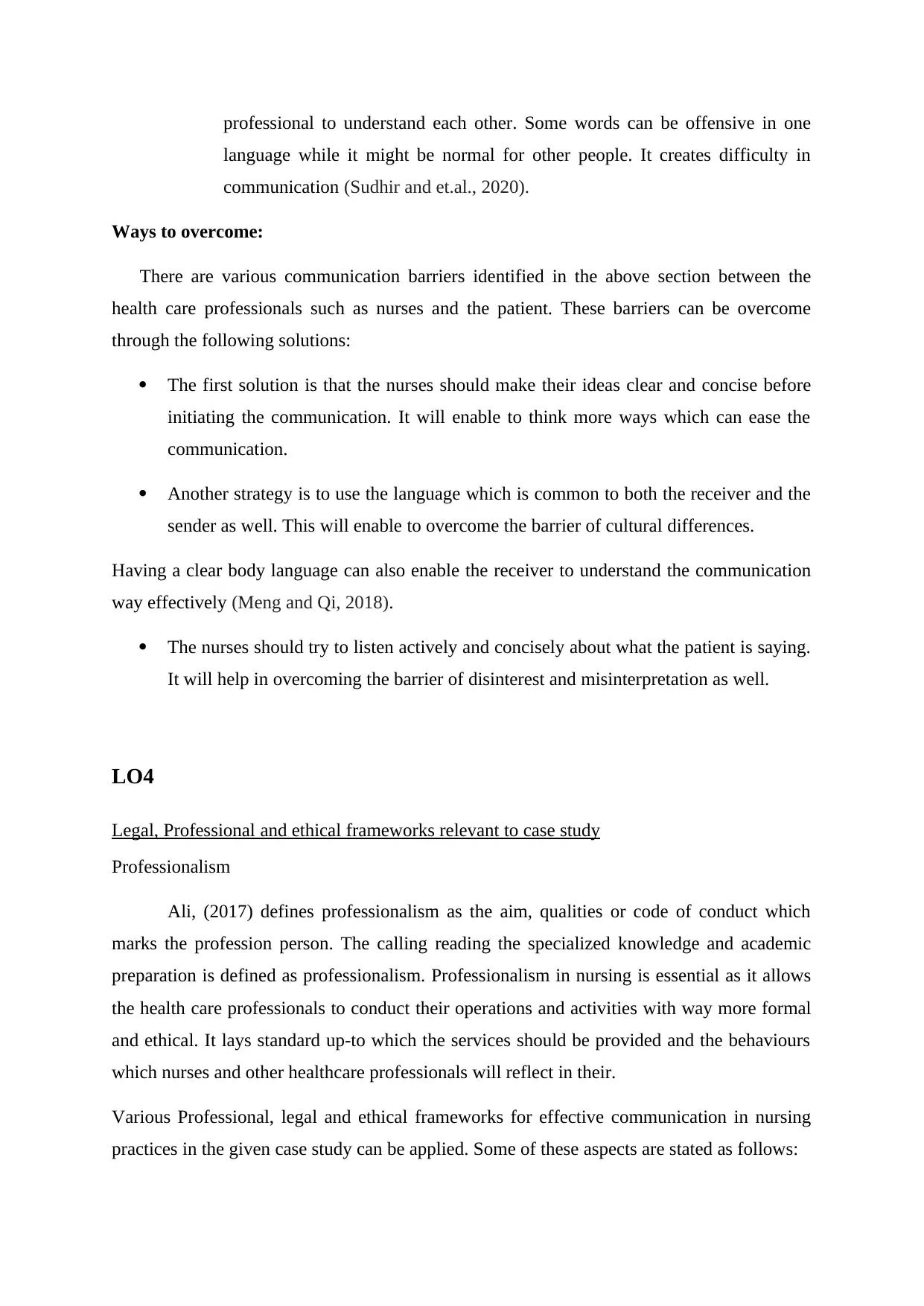
professional to understand each other. Some words can be offensive in one
language while it might be normal for other people. It creates difficulty in
communication (Sudhir and et.al., 2020).
Ways to overcome:
There are various communication barriers identified in the above section between the
health care professionals such as nurses and the patient. These barriers can be overcome
through the following solutions:
The first solution is that the nurses should make their ideas clear and concise before
initiating the communication. It will enable to think more ways which can ease the
communication.
Another strategy is to use the language which is common to both the receiver and the
sender as well. This will enable to overcome the barrier of cultural differences.
Having a clear body language can also enable the receiver to understand the communication
way effectively (Meng and Qi, 2018).
The nurses should try to listen actively and concisely about what the patient is saying.
It will help in overcoming the barrier of disinterest and misinterpretation as well.
LO4
Legal, Professional and ethical frameworks relevant to case study
Professionalism
Ali, (2017) defines professionalism as the aim, qualities or code of conduct which
marks the profession person. The calling reading the specialized knowledge and academic
preparation is defined as professionalism. Professionalism in nursing is essential as it allows
the health care professionals to conduct their operations and activities with way more formal
and ethical. It lays standard up-to which the services should be provided and the behaviours
which nurses and other healthcare professionals will reflect in their.
Various Professional, legal and ethical frameworks for effective communication in nursing
practices in the given case study can be applied. Some of these aspects are stated as follows:
language while it might be normal for other people. It creates difficulty in
communication (Sudhir and et.al., 2020).
Ways to overcome:
There are various communication barriers identified in the above section between the
health care professionals such as nurses and the patient. These barriers can be overcome
through the following solutions:
The first solution is that the nurses should make their ideas clear and concise before
initiating the communication. It will enable to think more ways which can ease the
communication.
Another strategy is to use the language which is common to both the receiver and the
sender as well. This will enable to overcome the barrier of cultural differences.
Having a clear body language can also enable the receiver to understand the communication
way effectively (Meng and Qi, 2018).
The nurses should try to listen actively and concisely about what the patient is saying.
It will help in overcoming the barrier of disinterest and misinterpretation as well.
LO4
Legal, Professional and ethical frameworks relevant to case study
Professionalism
Ali, (2017) defines professionalism as the aim, qualities or code of conduct which
marks the profession person. The calling reading the specialized knowledge and academic
preparation is defined as professionalism. Professionalism in nursing is essential as it allows
the health care professionals to conduct their operations and activities with way more formal
and ethical. It lays standard up-to which the services should be provided and the behaviours
which nurses and other healthcare professionals will reflect in their.
Various Professional, legal and ethical frameworks for effective communication in nursing
practices in the given case study can be applied. Some of these aspects are stated as follows:
⊘ This is a preview!⊘
Do you want full access?
Subscribe today to unlock all pages.

Trusted by 1+ million students worldwide

Ethical duty to care: This framework states that the nurses have the fundamental duty to assist
in the emergency situation even in the absence of the legal or professional duty of care. In the
case of Helen, the health care professionals have the ethical duty to provide her the care
services and listening to her as well.
Legislation:
The laws applicable in the case of Helen are as follows:
The Equality Act 2010: The act states that a patient must be treated equally regardless
of their age, disability, sex, religion or on the basis of marriage and civil partnership.
The law is applicable in the given case Helen should be treated as an individual who
seeks professional help jobs (Stickley, 2011). The laws prohibits nay kind of
discrimination to her.
Professionalism:
The code provides various professional standard which the midwives, nursing associates and
nurses must follow for being registered to practise in UK. In the given case of Helen,
following themes of professionalism are applicable:
Prioritise people: This code enables the nurses to treat the people as individual and
respect their dignity. In the given case Helen is patient who sometimes forget the
location and time. In her case the professionalism is maintained through treating her
with kindness and she is provided with fundamental care. It also states that the
physical, psychological and social needs of Helen are taken care of.
Practice effectively: This code states that the patient must be given best practices and
communicated clearly with the patient. In the given case, the nurse have the
obligation to practice in line with their best available evidences. However in the case
of Helen, the parents have decided not to tell Helen regarding her illness as it can
impact her health. So the practices are discussed with the family instead.
Ethical considerations
The ethical considerations applicable in the given case are as follows:
in the emergency situation even in the absence of the legal or professional duty of care. In the
case of Helen, the health care professionals have the ethical duty to provide her the care
services and listening to her as well.
Legislation:
The laws applicable in the case of Helen are as follows:
The Equality Act 2010: The act states that a patient must be treated equally regardless
of their age, disability, sex, religion or on the basis of marriage and civil partnership.
The law is applicable in the given case Helen should be treated as an individual who
seeks professional help jobs (Stickley, 2011). The laws prohibits nay kind of
discrimination to her.
Professionalism:
The code provides various professional standard which the midwives, nursing associates and
nurses must follow for being registered to practise in UK. In the given case of Helen,
following themes of professionalism are applicable:
Prioritise people: This code enables the nurses to treat the people as individual and
respect their dignity. In the given case Helen is patient who sometimes forget the
location and time. In her case the professionalism is maintained through treating her
with kindness and she is provided with fundamental care. It also states that the
physical, psychological and social needs of Helen are taken care of.
Practice effectively: This code states that the patient must be given best practices and
communicated clearly with the patient. In the given case, the nurse have the
obligation to practice in line with their best available evidences. However in the case
of Helen, the parents have decided not to tell Helen regarding her illness as it can
impact her health. So the practices are discussed with the family instead.
Ethical considerations
The ethical considerations applicable in the given case are as follows:
Paraphrase This Document
Need a fresh take? Get an instant paraphrase of this document with our AI Paraphraser

Informed consent: The consent or agreement of the person on the services and
treatment provided to them is very important. In the case of Helen, she forgets
everything so the informed consent is taken from her family on behalf of for her
treatment (Shorey and et.al., 2018).
Disclosure: The disclose ethic sates that personal information should not be shared
with anyone until it is necessary. In the case of Helen, her personal information
cannot be shared with prior informing to her family.
Conclusion
From the above discussion it can be concluded that communication is essential in
nursing and other health care practices. There are many communication strategies which a
healthcare professional can undertake to facilitate the flow of communication. However,
there are various barriers to the communication as well. The various Legal, Professional and
ethical frameworks relevant to case study are also discussed.
treatment provided to them is very important. In the case of Helen, she forgets
everything so the informed consent is taken from her family on behalf of for her
treatment (Shorey and et.al., 2018).
Disclosure: The disclose ethic sates that personal information should not be shared
with anyone until it is necessary. In the case of Helen, her personal information
cannot be shared with prior informing to her family.
Conclusion
From the above discussion it can be concluded that communication is essential in
nursing and other health care practices. There are many communication strategies which a
healthcare professional can undertake to facilitate the flow of communication. However,
there are various barriers to the communication as well. The various Legal, Professional and
ethical frameworks relevant to case study are also discussed.
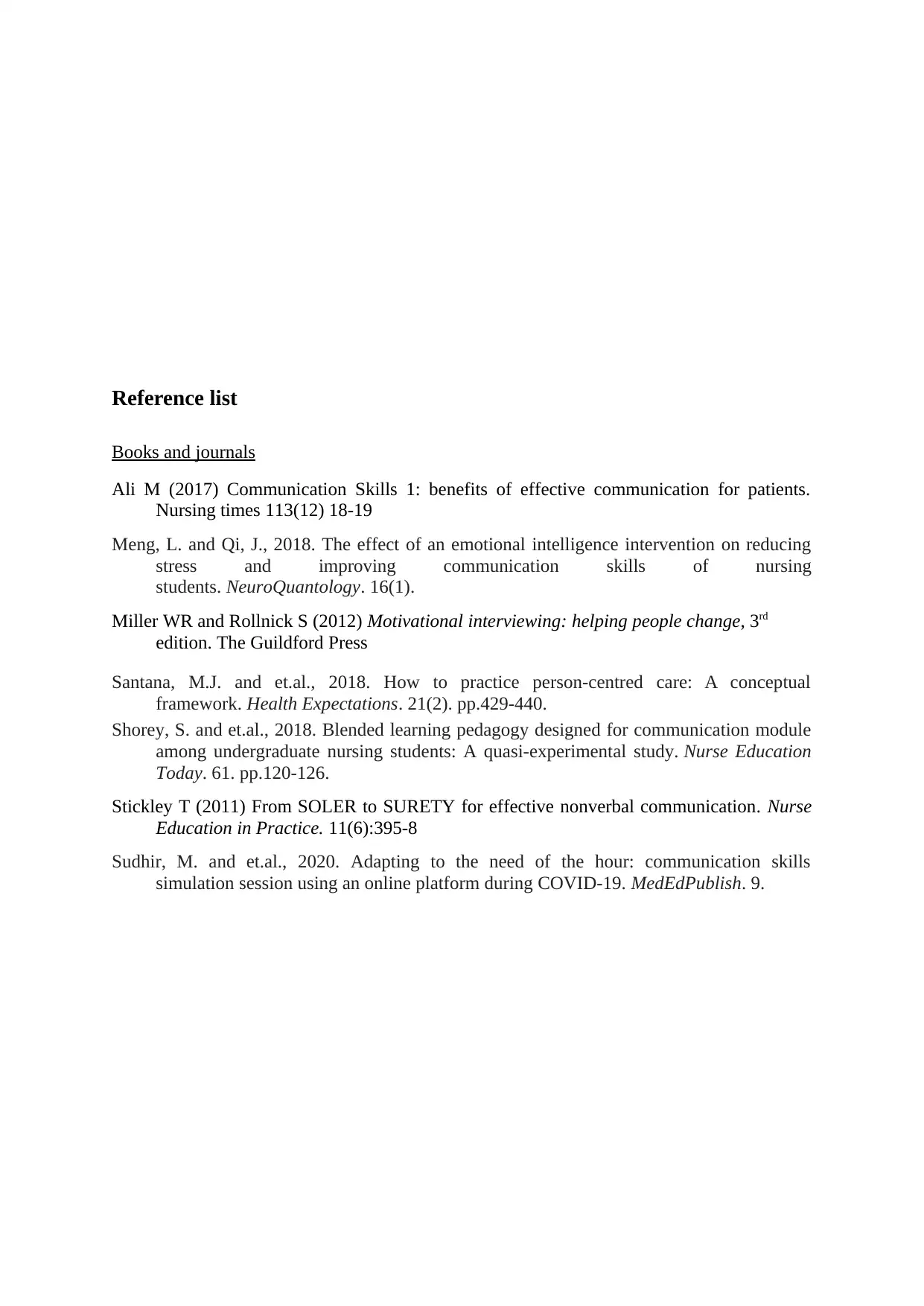
Reference list
Books and journals
Ali M (2017) Communication Skills 1: benefits of effective communication for patients.
Nursing times 113(12) 18-19
Meng, L. and Qi, J., 2018. The effect of an emotional intelligence intervention on reducing
stress and improving communication skills of nursing
students. NeuroQuantology. 16(1).
Miller WR and Rollnick S (2012) Motivational interviewing: helping people change, 3rd
edition. The Guildford Press
Santana, M.J. and et.al., 2018. How to practice person‐centred care: A conceptual
framework. Health Expectations. 21(2). pp.429-440.
Shorey, S. and et.al., 2018. Blended learning pedagogy designed for communication module
among undergraduate nursing students: A quasi-experimental study. Nurse Education
Today. 61. pp.120-126.
Stickley T (2011) From SOLER to SURETY for effective nonverbal communication. Nurse
Education in Practice. 11(6):395-8
Sudhir, M. and et.al., 2020. Adapting to the need of the hour: communication skills
simulation session using an online platform during COVID-19. MedEdPublish. 9.
Books and journals
Ali M (2017) Communication Skills 1: benefits of effective communication for patients.
Nursing times 113(12) 18-19
Meng, L. and Qi, J., 2018. The effect of an emotional intelligence intervention on reducing
stress and improving communication skills of nursing
students. NeuroQuantology. 16(1).
Miller WR and Rollnick S (2012) Motivational interviewing: helping people change, 3rd
edition. The Guildford Press
Santana, M.J. and et.al., 2018. How to practice person‐centred care: A conceptual
framework. Health Expectations. 21(2). pp.429-440.
Shorey, S. and et.al., 2018. Blended learning pedagogy designed for communication module
among undergraduate nursing students: A quasi-experimental study. Nurse Education
Today. 61. pp.120-126.
Stickley T (2011) From SOLER to SURETY for effective nonverbal communication. Nurse
Education in Practice. 11(6):395-8
Sudhir, M. and et.al., 2020. Adapting to the need of the hour: communication skills
simulation session using an online platform during COVID-19. MedEdPublish. 9.
⊘ This is a preview!⊘
Do you want full access?
Subscribe today to unlock all pages.

Trusted by 1+ million students worldwide
1 out of 9